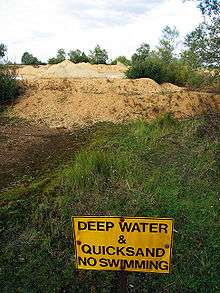Quicksand
Quicksand is a colloid consisting of fine granular material (such as sand, silt or clay) and water.

Quicksand forms in saturated loose sand when the sand is suddenly agitated. When water in the sand cannot escape, it creates a liquefied soil that loses strength and cannot support weight. Quicksand can form in standing water or in upward flowing water (as from an artesian spring). In the case of upward flowing water, forces oppose the force of gravity and suspend the soil particles.
The saturated sediment may appear quite solid until a sudden change in pressure or shock initiates liquefaction. This causes the sand to form a suspension and lose strength. The cushioning of water gives quicksand, and other liquefied sediments, a spongy, fluid-like texture. Objects in liquefied sand sink to the level at which the weight of the object is equal to the weight of the displaced soil/water mix and the submerged object floats due to its buoyancy.
Liquefaction is a special case of quicksand. In this case, sudden earthquake forces immediately increase the pore pressure of shallow groundwater. The saturated liquefied soil loses strength, causing buildings or other objects on that surface to sink.
Quicksand condition occurs in upward flow when the Critical Hydraulic Gradient come in the Vicinity of unity.[1]
Properties
Quicksand is a shear thinning non-Newtonian fluid: when undisturbed, it often appears to be solid ("gel" form), but a less than 1% change in the stress on the quicksand will cause a sudden decrease in its viscosity ("sol" form). After an initial disturbance—such as a person attempting to walk on it—the water and sand in the quicksand separate and dense regions of sand sediment form; it is because of the formation of these high volume fraction regions that the viscosity of the quicksand seems to decrease suddenly. Someone stepping on it will start to sink. To move within the quicksand, a person or object must apply sufficient pressure on the compacted sand to re-introduce enough water to liquefy it. The forces required to do this are quite large: to remove a foot from quicksand at a speed of 0.01 m/s would require the same amount of force as needed to lift a car.[2]
It is impossible for a human to sink entirely into quicksand[3] due to the higher density of the fluid (assuming the quicksand is on dry ground and not underwater, but even if underwater, sinking is still improbable). Quicksand has a density of about 2 grams per milliliter, whereas the density of the human body is only about 1 gram per milliliter. At that level of density, sinking beyond about waist height in quicksand is impossible. Even objects with a higher density than quicksand will float on it if stationary. Aluminum, for example, has a density of about 2.7 grams per milliliter, but a piece of aluminum will float on top of quicksand until motion causes the sand to liquefy.[4]
Continued or panicked movement, however, may cause a person to sink further in the quicksand. Since this increasingly impairs movement, it can lead to a situation where other factors such as weather exposure, dehydration, hypothermia, tides or predators may harm a trapped person.[5]
Quicksand may be escaped by slow movement of the legs in order to increase viscosity of the fluid, and rotation of the body so as to float in the supine position (lying horizontally with the face and torso facing up).[4]
In popular culture
Quicksand is a trope of adventure fiction, particularly in film, where it is typically and unrealistically depicted with a suction effect that causes people or animals that walk into it to sink and risk drowning. This has led to the popular perception that humans can be completely immersed and drown in quicksand; as previously explained, this is not physically possible.[6] According to a 2010 article by Slate, this gimmick had its heyday in the 1960s, when almost 3% of all films showed characters sinking in clay, mud, or sand.[7]
See also
- Dry quicksand
- Quick condition
- Sapric (a soil of very decomposed organic material)
- Tar pit
- Grain entrapment
References
- "Quicksand Condition – Occurrence Mechanism and Preventive Measures". The Constructor. 2019-06-22. Retrieved 2020-01-20.
- Khaldoun, A., E. Eiser, G. H. Wegdam, and Daniel Bonn. 2005. "Rheology: Liquefaction of quicksand under stress." Nature 437 (29 Sept.): 635. doi:10.1038/437635a
- "Will Quicksand Really Kill You?". The Science Explorer. Retrieved 2020-04-08.
- Bakalar, Nicholas (September 28, 2005). "Quicksand Science: Why It Traps, How to Escape". National Geographic News. Retrieved October 9, 2011.
- Discovery Channel. MythBusters. Season 2. "Killer Quicksand." October 20, 2004.
- Thursday, 29 September 2005 Patricia ReaneyReuters (2005-09-29). "Quicksand myth exposed". www.abc.net.au. Retrieved 2020-04-08.
- Engber, Daniel (23 August 2010). "Terra Infirma: The rise and fall of quicksand". Slate. Retrieved 23 August 2010.
External links
| Wikimedia Commons has media related to Quicksand. |
| Wikiquote has quotations related to: Quicksand |
- Howstuffworks.com - How quicksand works
- "What is quicksand?". Scientific American.
- Video showing quicksand in a sandpit YouTube